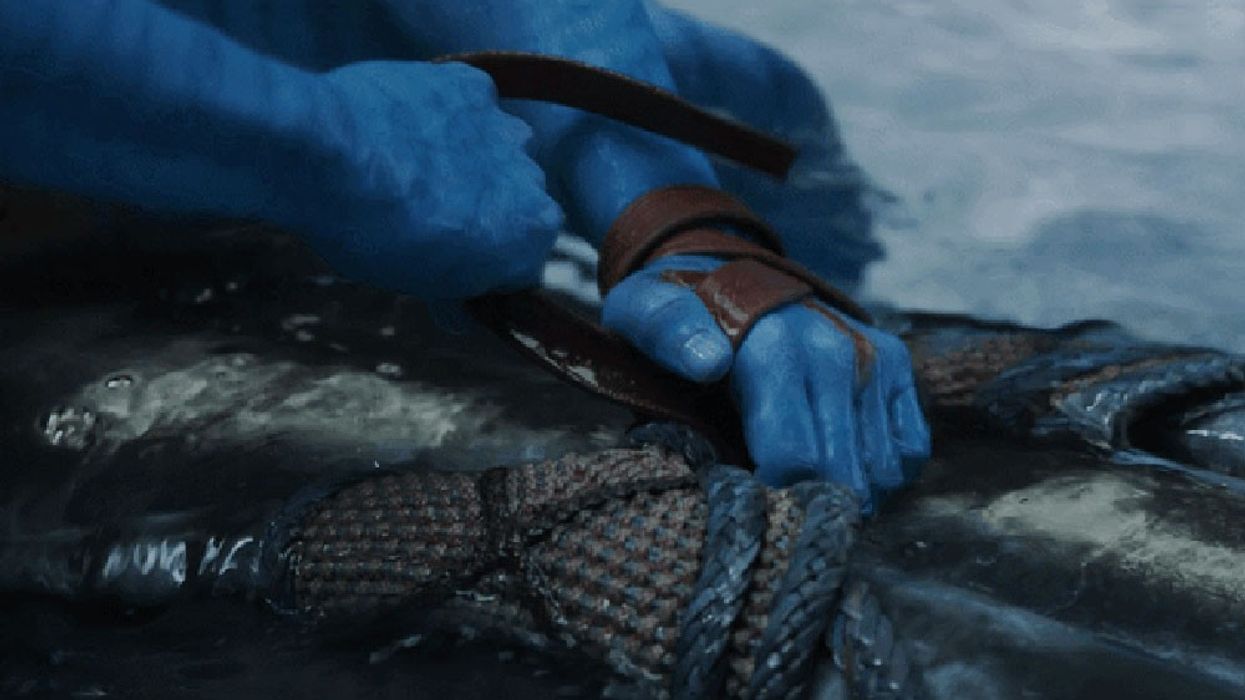What's the Truth About That One Shot From 'Avatar: The Way of Water'
Fans and filmmakers alike simply can't tell if the shot was created using a real or camera VFX.

In the James Cameron sequel, Avatar: The Way of Water, there is a simple pickup shot of a digital character wrapping a leather strap around a blue arm, much like a bronco rider would in real life. The image is ordinary, but it's also compelling due to the nature of this film's production, so much so that it’s got fans and digital artists alike arguing about whether it’sreal, CGI, or both. For many, you just can’t tell.
The original Avatar, made in 2009, introduced the Na’vi, a blue-skinned race of extraterrestrial giants who are battling humans for control of their planet, Pandora. Fifteen years later, the sequel shows us what has happened to this tribe. While some fans are saying there's nothing new about the effects-laden sequel, others are looking at even the most mundane of shots and wondering how they were really done.
Diving Into The Deep Blue
The more powerful computer systems get, the more complicated visual effects can be. In Avatar: The Way of Water, those effects had to be constructed around a mostly underwater environment, most likely borrowing from James Cameron'sobsession with our own ocean. The post-production team atWētā FX created a host of new visual effects techniques, including underwater motion capture, which has changed the way filmmakers will be looking at complicated CGI moving forward.

“This is coming from Jim’s desire to treat the digital world and the real world the same,” Wētā FX director Joe Letteri said in an interview appearing in a special section of the Below-the-Line issue of TheWrap’s awards magazine.
“He wanted to use the camera like a real camera, see his actors, see the lighting, art-direct the shots, move sets, and dressing around,” Letteri added. “This was the core of building all of that together. And it paid off because it carried over into the live-action shoot.”
Letteri said that traditionally, visual effects adopt a layer approach, mainly a holdover from the days of compositing on film using bluescreen. Think Adobe’sPhotoshop andAfter Effects workflows.
With Avatar: The Way of Water, they had to reimagine how VFX could be accomplished in more complex situations. The team developed a technique that uses (you guessed it) artificial intelligence to interact more naturally with the environment.
“But if you imagine a character walking around a tree within one shot, at one point they’re in front of it and another they’re behind it,” Letteri said. "We created a neural network to train for what we were shooting."
With that kind of focus, it was inevitable that audiences would see visual effects shots that they weren’t altogether certain were made with a computer.
That One Shot
But there is one shot that has people arguing on Reddit, YouTube, and even Twitter about how it was created.
It is the one of Jake Sully (Sam Worthington), who is now a full-fledged Na’vi. In this shot, he is cinching up a leather strap to a saddle on top of an iLu, a dolphin-like creature, so he can keep a better grip to stay on the animal.
The shot lasts about a second, maybe two, but it has fans and visual effects artists alike arguing about digital water bubbles, skin illumination, and surface tension, while others are convinced it was a simple live shot of an actor. It turns out it was a little bit of both.
The shot in question from 'Avatar: The Way of Water'Credit: 20th Century Studios
The team at Wētā FX crafted a real-world saddle for the iLu, and used it for the main live-action plate. “We actually shot that in a kid’s pool,” added visual effects supervisor Eric Saindon. “And what we ended up using out of it was in between where everyone was guessing. We replaced the arm and the body, and we had to get an iLu in there. The reality falls between the Reddit conversation and the recent articles that said it was all live-action.”
For all the amazing technology that the Avatar films have created, this one shot that everyone has been talking about was the most traditional of the bunch. A simple plate with some elements replaced with CGI.
Don't Reinvent The Wheel
Wētā’s ever-growing list of new effects patents shows that the VFX company has developed the tools needed to make the shot look as realistic as possible. Now, it’s even got other professional visual effects artists debating how they did it, and that ends up being the ultimate compliment.
Like any magic trick, it makes one want to know how they did that. The fact that it is one very simple shot that makes people want to know even more reminds us that the fundamentals of filmmaking and basic VFX can make something great. Sometimes, you don't really need to reinvent the wheel. You just have to make excellent use of the wheel.
Let us know what you think of the shot in the comments below!
Source: The Wrap

 'Anora'Neon
'Anora'Neon Annie Johnson Kevin Scanlon
Annie Johnson Kevin Scanlon









